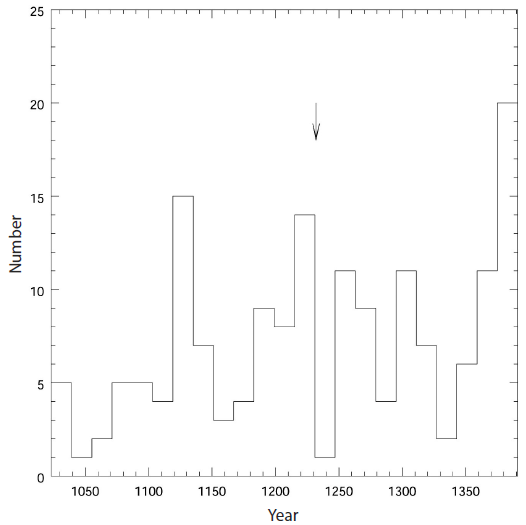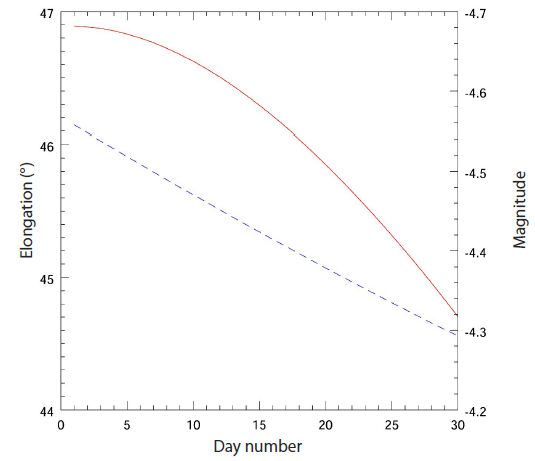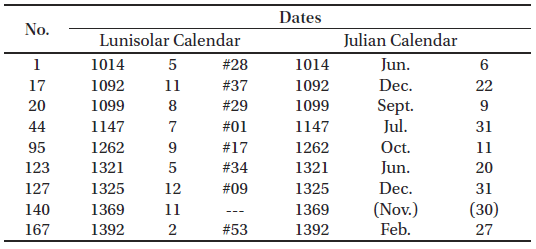1. INTRODUCTION
Venus is an inferior planet and can therefore be seen from Earth only at around sunrise or sunset, with a maximum angular distance from the Sun (i.e., greatest elongation) of ~47° (Urban & Seidelmann 2012). This is the reason why, throughout history, Venus has often been called the morning or evening star. Venus, being the brightest planet in the night sky, was named after the goddess of love and beauty in the western culture. In ancient Korean civilization, Venus was generally named the Taebaekseong (太白星, Great While Star) because of its white light, and much attention was given to its movement and color changes in the context of astrology. This was also the case for other East Asian dynasties. According to the Cheonmunryucho (天文類抄, Selected and Classified Writings on Astrology), compiled by Lee Sunji in the Joseon dynasty (the dynasty that followed the Goryeo dynasty, A.D. 1392-1910), the movement and color changes of Venus were related to evil omens (Kim & Yoon 2009). In particular, the appearance of Venus in daytime was considered to be the harbinger of revolution in a dynasty. Therefore, Venus was thoroughly observed in ancient Korea and these observations were recorded in the history books of each dynasty, such as the Goryeosa (History of the Goryeo Dynasty, A.D. 918-1392).
It was Halley who first determined that the point of maximum brightness of Venus (when viewed from Earth) is at 40° on either side of its inferior conjunction (Hogg 1947). According to the Seoungwanji (Records of the Royal Astronomical Bureau) compiled by Seong Judeok (a royal astronomer) in 1818, Joseon astronomers also knew this fact (refer to Lee et al. 2003), presumably from the experience of long observations. It is not easy to find Venus with the naked eye in daylight (i.e., when the Sun is up), but it can be found by a skilled observer who is familiar with its movement, particularly when the sky is deep blue in color (Peters 1984; Ellis 1995). There are numerous accounts of daytime observations of Venus (with the naked eye, of course) in the Korean historical literature. However, it is unclear whether these events correspond to observations during daylight or twilight (e.g., Stephenson & Yau 1985). In this study, we investigated the accounts of daytime appearances of Venus in the Goryeosa, focusing on the observation time (i.e., whether it was twilight or daylight time), to estimate the practical conditions for the observation of Venus with the naked eye in broad daylight.
The rest of this paper is organized as follows. In Section 2, we present the modern astrophysical calculations related to the daytime appearance of Venus such as its azimuth, altitude, solar elongation, and magnitude. In Section 3, we describe the accounts of these events given in the Goryeosa, and discuss some of the more remarkable accounts. In Section 4, the accounts from the Goryeosa are compared with the results from the modern calculations and the comparison results are presented. Finally, Section 5 summarizes our findings and concludes the paper.
2. MODERN CALCULATIONS
Many ephemerides for observable physical quantities of the planets are currently available, e.g., BDL 82 (Francou et al. 1983) and VSOP87 (Bretagnon & Francou 1988); other ephemerides have been given by Simon et al. (1994). In this study, we used the DE406 ephemeris of Standish et al. (1997) and the astronomical algorithms of Meeus (1998), which have used most of the available observations. For the value of T, which is the difference between terrestrial time and universal time (UT), we used the recent results presented by Morrison & Stephenson (2004). The quantity T is one of the important elements for the calculation of historical astronomical phenomena. It has a value of approximately 12.3 min for the year 1200 and can be interpolated from the table given by Morrison & Stephenson (2004), which is tabulated at intervals of one hundred years, for a given year.
We first calculated the sunrise and sunset times for the dates at which the daytime appearance of Venus was recorded, and then obtained the azimuth, altitude, solar elongation, and magnitude of Venus at those times. The sunrise and sunset Ahn et al. (2009) to convert the lunisolar calendar dates of the Goryeosa into the Julian calendar dates. We also calculated the azimuth, altitude, elongation, and magnitude of Venus at sunrise of the following day, considering the possibility that the Goryeo court did not change the date of occurrence of the astronomical phenomenon occurred after midnight (Lee et al. 2016), which was the case in the Joseon court (Ahn & Park 2004).
If the altitude of Venus at sunrise or sunset is less than zero, this implies that Venus was seen (with the naked eye) in daylight (i.e., when the Sun is up). In this study, we assumed the observer’s location to be Gaegyeong (the capital of the Goryeo dynasty, nowadays Gaeseong), although Gangdo (nowadays Ganghwa Island) was used as a temporary capital for 39 yr starting from 1232 because of the Mongol invasion. We also assumed′ that the latitude′ and longitude of Gaegyeong are′ 37° 58 ′N and 126° 33 E, respectively (Gangdo: 37° 45 N, 126° 29 E). To verify our calculations for the apparent position of Venus, we compared our results with the values presented in the Astronomical Almanac for the year 2015 (Naurical Almanac Office 2014). They were found to be in good agreement;′ for 2015 July 5.0 TT, the differences are 0.002 sec and 0.03 in right ascension and declination, respectively. To calculate the apparent magnitude of Venus, we used the following equations (Hilton 2005): where i is the phase angle of Venus in degrees. Our calculations for the apparent magnitude were also found to be in exact agreement with the values of the Astronomical Almanac. Throughout this paper, the dates and the times are given as Julian dates and in Korean Standard Time (i.e., UT+9 hr), respectively, unless mentioned otherwise. Finally, the results for the azimuth, altitude, elongation, and magnitude of Venus are presented only for the sunset time, because within a single day there are no significant differences in both elongation and magnitude values.
3. GORYEOSA ACCOUNTS
We surveyed the Goryeosa for the accounts of daytime appearances of Venus and found a total of 167 accounts. The contents of these accounts are very plain and simple with a few notable exceptions. Typically, these accounts will only say that “Venus was seen during the day [太白晝見],” without referring to the observation time, direction, or any other astronomical detail. In most accounts, however, the statement “(and Venus) passes through the sky [(太白)經天],” (literal translation) is followed by the statement “Venus was seen during the day.” The astronomical phenomenon denoted by the former statement is unclear. However, according to the account of the Joseonwangjo-Sillok (Annals of the Joseon Dynasty) of 1497, September 27, this is the event that Venus appears in the southern direction [午地] of the sky.
In Appendix I, we have listed the physical observations for the 167 accounts. In this appendix, the first column represents the sequential numbering of accounts. Columns 2, 3, and 4 represent the year, month, and day respectively according to the lunisolar calendar, and columns 5, 6, and 7 represent the corresponding values according the Julian calendar. For convenience, we used numbers to denote the months, and added 12 to the number for a lunar leap month. As the dates in the Goryeosa are recorded using the sexagenary cycle, we expressed the cycle using the notation from the work of Lee et al. (2012); Arabic numbers used the prefix #, e.g., #01 is Gabja (甲子). We referred to the works of Han (2001) and Ahn et al. (2009) for converting the dates in the lunisolar calendar into dates of the Julian calendar, as mentioned above. Columns 8, 9, 10, and 11 represent the azimuth, altitude, elongation, and magnitude of Venus at sunset respectively.

|
Even though we only cataloged 167 accounts in Appendix I, the actual number of days in which Venus was seen during the daytime is more than 167 as some accounts say that Venus was also seen on the next day, for three successive days, and so on. Table 1 lists the accounts from the Goryeosa worth to be addressed. The number in the first column indicates the sequential number of the event as given in the full list presented in Appendix I.
The first account of a daytime appearance of Venus was recorded in 1014 (No. 1), although the astronomical phenomenon “a large star was seen in the east direction and changed into a white gas” was recorded as early as 932. The last account was recorded in 1392 (No. 167), when the Goryeo dynasty fell. Meanwhile, a 1092 account (No. 17) says that Venus was seen during the day for three years. However, Venus could not have been observed in daytime for such a long period, not even if for a year-round.
An interesting account is the one of 1099, September 6 (No. 20). It says that Jupiter was also seen during daytime. According to our calculations, the altitude and magnitude of Jupiter at sunset on that date were –29.27° and -2.4, respectively. The authenticity of the account is therefore questionable because it is known that the limiting stellar magnitude for visibility during broad daylight is approximately –3.3 (Weaver 1947). However, as pointed out by Park & La (1994), September corresponds to the onset of autumn, a season in which the sky is the bluest in Korea. That is, a known good condition to observe bright celestial bodies in daylight (Peters 1984;Ellis 1995). A more important point is that Jupiter has been actually observed in broad daylight (e.g., Russell 1918;Peck 1940;Sampson 2003). Therefore, if this account is true, it is valuable to validate another account of the Goryeosa of 1222, September 9: a comet was seen during the day. According to the work of Kronk (1999), this comet was Halley, in its 1222 apparition (see also Lee et al. 2014). One of most interesting accounts is that of 1147, July 31 (No. 44); it states that “Venus was seen in the morning twilight (at dawn) after the full moon day of June and appeared in the southern direction of the sky. Now it was successively seen in the daytime again [太白 自六月望後晨見經天今又連日晝見].” In addition, the account of 1117, August 31 says that “a meteor as large as the Moon fell in the southeast direction of the sky in the evening twilight (at dusk) [黃昏流星如月落於巽方].” Both accounts imply that daytime (晝) indicates the daylight period, neither morning twilight (晨) nor evening twilight (昏).
In the accounts of 1262, October 11 (No. 95) and 1321, June 20 (No. 123), the chroniclers additionally say that Venus “invaded [犯]” the Moon and Sun, respectively. An invasion is an event in which the beams of light from two celestial bodies are within a Chon (寸) and influence each other (Lee et al. 2003). According to the work of Stephenson & Green (2004), a Chon was approximately one degree in the astronomical records of the Joseon dynasty. The angular distance between Venus and the Moon was ~2.5° in 1262, October 11, but both were close up to ~1.1° on the day before. On the other hand, Venus was ~43° away from the Sun in 1321, June 20. Even considering the possibility that the reference to the Sun [日] being a typographical error where a reference to the Moon [月] was intended, we found that the Moon was also far from Venus on that day. One of the dates in which Venus closely approached to the Moon was one month earlier, that is, on 1321, May 31. On this day, Venus and the Moon were ~2.8° apart.
According to the work of Han (2001), there is no #09 day in the lunar month of December in 1325 (No. 127). However, the sexagenary cycle of the 26th day of the lunar month of November of the same year (i.e., 1325, December 31, in the Julian calendar) is #09; we therefore used this date for our study. Lastly, we found that in six accounts the days are not specified (i.e., the sexagenary cycle of the day is not specified), which includes the account of November 1369 (No. 140). For these cases, we used a dash symbol for the day in the lunisolar calendar and presented the Julian date corresponding to the first day of the lunar month using parentheses (Han 2001). For example, in entry No. 140 in Table 1, we used the date of 1369, November 1 in the lunisolar calendar, which corresponds to 1369, November 30 in the Julian calendar.
4. RESULTS
Before verifying the daytime appearances of Venus, we analyzed the number distribution of the observation accounts. The synoptic period of Venus is 583.92 days, i.e., ~1.6 yr (Lang 2012), and Venus reaches its maximum brilliance twice during this period, around its east and west elongations. Fig. 1 shows the number distribution of 164 accounts in 16 yr intervals, from 1023 to 1391. The remarkable feature of the distribution is that its minimum is at around 1232 (marked with an arrow), when the Goryeo court moved the capital to the Gangdo because of the Mongol invasion, and its maximum is at around 1390, when the dynasty began to fall. Hence, it seems that the records of the daytime appearances of Venus, which require observations by an expert, have been influenced by political events, even though Yang & Choi (2012) have previously concluded that the Korean historical astronomical records were not influenced by political events based on the analysis of meteor (shower) records, which could be observed by non-experts.

To analyze the daytime appearances of Venus, we calculated the azimuth, altitude, elongation, and magnitude of Venus at sunset for 161 accounts for which the day is specified. However, we could not calculate the magnitude of Venus for two of these accounts (No. 25 and 48), because the phase angles of Venus for them were outside the range of Eq. (1) (i.e., greater than 170.2°). The fact that the phase angles are so close to 180° indicates that Venus was close to its superior conjunction; in other words, Venus was very close to the Sun, when seen from Earth. Hence, it would be hard to observe Venus with the naked eye because of the bright sunlight. Therefore, we think that either the contents of both these accounts or their date conversion into the Julian calendar might be wrong. Using the remaining 159 accounts, we found the mean values of magnitude and elongation to be -4.5±0.3 and 39.8°±7.3, respectively. In particular, the fact that the mean value of elongation is ~40°, which is the point of maximum brilliance of Venus as determined by Halley, strongly suggests that Venus must have been observed in daylight (i.e., when the Sun was up) and not at twilight, if it is true that Venus was observed.
Lastly, we tried to estimate the dates for the six accounts for which the days are not specified in the Goryeosa based on the calculations of the elongation and magnitude for a full month (i.e., for 29 or 30 days). However, we found that there are no significant changes during a month to support an estimate or at least constrain the observation date. For instance, Fig. 2 shows the variations of the elongation and magnitude of Venus (the red solid and blue dotted lines, respectively) for the period from 1369, November 30 to December 29 (i.e., from 1369, November 1 to 30 in the lunisolar calendar). In the figure, the horizontal axis represents the number of days since 1369, November 30, and the left and right vertical axes represent the elongation and magnitude, respectively.

5. SUMMARY
In this paper, we investigated the accounts of the daytime appearances of Venus in the Goryeosa, focusing particularly on whether daytime in these accounts implies daylight (i.e., when the Sun is up) or may also consider twilight. We first surveyed all accounts of the daytime appearances of Venus in the Goryeosa and found a total of 167 accounts, including six for which the days are not specified, and one for which the sexagenary cycle of the day is wrong. We then developed an astronomical algorithm to calculate the azimuth, altitude, solar elongation, and magnitude of Venus at sunset on the days of the reported sightings, using the DE 406 ephemeris.
Using the 164 accounts dating from 1023 to 1391, we analyzed the number distribution of the accounts in intervals of 16 yr, based on the synoptic period of Venus. We found that the distribution shows a minimum in the vicinity of 1232, when the Goryeo dynasty moved the capital to Gangdo, and a maximum in the vicinity of 1390, when the dynasty began to fall. We analyzed the data for the physical quantities of Venus such as azimuth, altitude, elongation, and magnitude at sunset. We found that the average values of elongation and magnitude of Venus were ~40° and −4.5, respectively. The elongation value, in particular, showed good agreement with the known elongation values at which Venus reaches its maximum brilliance. This fact strongly suggests that daytime in these accounts indicates daylight, not twilight. That is, if Venus was observed on those dates, then it was observed when the Sun was up. In addition, we tried to estimate the observation date of the accounts for which the day was not completely specified. However, we found that it is hard to estimate (or at least constrain) the date because the elongation and magnitude change slowly during the course of one month. We think that this study can help estimate the practical conditions for observations of Venus during daylight with the naked eye, and also bring additional insight into the historical observation reports contained in the Goryeosa.











